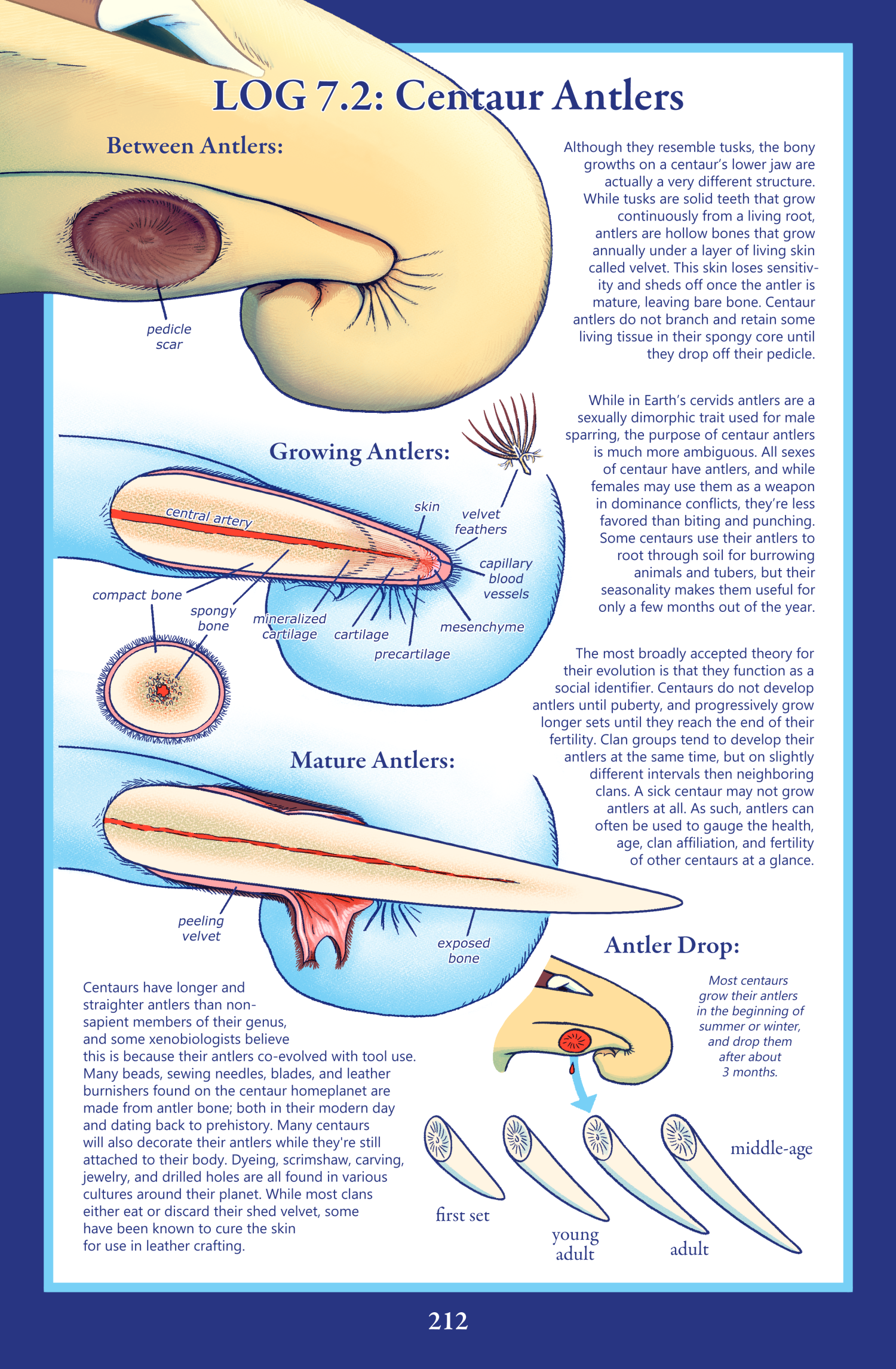I get peeved when people call these tusks because then they ask me why Talita doesn't cut them off or sand them down. While they're growing, that would be like sanding down your elbow. After they've grown, most of the length still has blood in it. (Not that this has stopped homeplanet centaurs from drilling holes in them and et cetera, but it would definitely stop a weenie like Talita.)
The miscellaneous over-long tangent I decided to leave off this page is that many of the Biing islanders, a centaur ethnicity mentioned on the lore website, put their growing antlers inside a form to make them curved. This has its origin in them using their antlers to make fish hooks, but it has taken on a life of its own as cultural tradition. The more curved your antlers are, the higher your status, particularly in young marriageable males.
Also, last chance for character AMA questions. Submit questions over here!
Transcript
LOG 7.2: Centaur Antlers
Although they resemble tusks, the bony growths on a centaur’s lower jaw are actually a very different structure. While tusks are solid teeth that grow continuously from a living root, antlers are hollow bones that grow annually under a layer of living skin called velvet. This skin loses sensitivity and sheds off once the antler is mature, leaving bare bone. Centaur antlers do not branch and retain some living tissue in their spongy core until they drop off their pedicle.
While in Earth’s cervids antlers are a sexually dimorphic trait used for male sparring, the purpose of centaur antlers is much more ambiguous. All sexes of centaur have antlers, and while females may use them as a weapon in dominance conflicts, they’re less favored than biting and punching. Some centaurs use their antlers to root through soil for burrowing animals and tubers, but their seasonality makes them useful for only a few months out of the year. The most broadly accepted theory for their evolution is that they function as a social identifier. Centaurs do not develop antlers until puberty, and progressively grow longer sets until they reach the end of their fertility. Clan groups tend to develop their antlers at the same time, but on slightly different intervals then neighboring clans. A sick centaur may not grow
antlers at all. As such, antlers can often be used to gauge the health, age, clan affiliation, and fertility
of other centaurs at a glance.
Centaurs have longer and straighter antlers than non-sapient members of their genus, and some xenobiologists believe this is because their antlers co-evolved with tool use. Many beads, sewing needles, blades, and leather burnishers found on the centaur home planet are made from antler bone; both in their modern day and dating back to prehistory. Many centaurs will also decorate their antlers while they're still attached to their body. Dyeing, scrimshaw, carving, jewelry, and drilled holes are all found in various cultures around their planet. While most clans either eat or discard their shed velvet, some have been known to cure the skin for use in leather crafting.
Between Antlers:
Image: A profile of a centaur’s snout shows one of the dark oval markings on the sides of their lower jaw.
-
pedicle scar
Growing Antlers:
Image: The same profile shows the antler beginning to grow from the pedicle in cut away. The tip is full of blood vessels and gradually hardens into bone as the structure elongates.
-
central artery
-
skin
-
velvet feathers (Image: An integument structure with a short, tiny quill from which a flat comb of fur-like bristles emerge on one axis, and a pair of branched downy filaments emerge on the other axis.)
-
capillary blood vessels
-
mesenchyme
-
precartilage
-
cartilage
-
mineralized cartilage
-
spongy bone
-
compact bone
Mature Antlers:
Image: The same profile shows a cutaway of the finished bone, with velvet skin shedding off.
-
peeling velvet
-
exposed bone
Antler Drop:
Most centaurs grow their antlers in the beginning of summer or winter, and drop them after about
3 months.
Image: The antler detaches from the jaw, leaving a raw red pedicle behind to heal back into the dark pedicle scar. A series of antlers shows them increasing in length with age.
-
first set
-
young adult
-
adult
-
middle-age








43 thoughts on “Runaway to the Stars: Page 212”
jdeltia
so, will these logs be published in the actual final book? they do have page numbers…
Eupteryx
Have any of the non-sapient members of the centaur genus survived into the time period of the comic?
Casandraelf
meanwhile, there’s talita, who just throws her velvet away XD
Gar G
Honestly I was actually thinking about this earlier, or rather something along the lines
I remember it was stated that the Centaur Homeworld went through a recent mass extinction event, so most of the dominant lifeforms are descendant from a relatively recent common ancestor, a shrew-like creature that possessed a pair of tusk-like antlers (which other creatures at the time might not have possessed), and thus retain these ancestral traits, some evolving to make use of them, and some just holding onto them because there was no reason to lose them. Was fascinating for me to think about
Jay Eaton
That lore is mostly outdated, sorry. I complicated their evolutionary history
JoB
Way late question because I didn’t have the reference handy back then, but: That piece of furniture smack in the middle of double page 205/206, is that a properly-adapted centaur bed?
(… which looks not like the one Talita uses, see page 35 …)
jdeltia
oh wow that’s a great catch, looks like it is
Stray Cat
The one thing I can think of to add to this is that, AFAIK, there is one exception to the rule of only male deer having antlers: caribou/reindeer.
Actually, a second thing – this touches on one of the reasons I love fantasy and sci-fi in the first place. The various aliens’ physiologies aren’t just for aesthetic reasons; their lives are shaped by it to some degree. Of course antlers would be a part of centaur culture!
JoB
Reindeer are the only cervid species where females routinely have antlers too, but if the occasional occurrences are any indication, the other cervids’ physiology/biochemistry isn’t as far from “antlers for everyone!!” as it is from, say, a hexapedal body plan.
Stray Cat
Fair point, and I admit I’d forgotten about those occasional occurrances. (Which is embarrassing since those kinds of occurrances aren’t specific to deer – see maned lionesses.)
Boxthing
I would LOVE to see the rooting and sparring centaurs!
Arcstone
Can these break? Like if a centaur falls on it’s face hard enough mid-print?
Like how hard does that suck? Do they bleed really bad?
DasGanon
I mean that happens to Deer, so “yes”, they break and it probably hurts, but they’re “fine” but unlike Deer which are skittish morons made of muscle, you’d think most Centaurs would have the foresight to catch themselves if they were to trip.
jdeltia
and tripping is probably less likely when you have 6 whole legs to catch yourself with
Stubbed Antler
It’s probably a case of “if you’re falling hard enough on your face to break an antler, you have other things to worry about being damaged over an antler”
Gheesfellow
All I can think looking at these nerves is *ouch*
Claire
How common is asymmetric antler size?
JoB
Very, if you look at the right time of the cycle. 😉
Claire
I’m talking more like how sometimes a buck will have a several point antler on one side, and the other failed to develop past a few inches. Do Centaur antlers sometimes fail? Is it congenital, or just for a season typically? That kind of situation.
Solidago
I think that usually happens due to injury to the velvet, so, it probably happens to centaurs too!
bryn
i love seeing this technical and biological information deep dive on centaur anatomy, capping off this chapter about talitas antlers. the contrast between bips diligent explanation of the antler velvet blanket just before this and the rather small footnote on antler sheds in leatherwork is interesting
rustbird
oooh, it’s really neat to know the Biing curved antlers are something they do to themselves instead of a genetic thing.
Teod
The tool use note is fascinating. Reminds me of the Centaur ethnicities chart – the only ones with curved antlers are islanders. Did they use them to make fishhooks?
Claire
Yes, Jay confirms this in the description.
A Box Of Fox
I wonder what the heck kind of bigass fish bites an entire antler, though…
JoB
Hmmm … I’d guess that Talitas antlers are about 25 cm long … “bent” into a circle, that’d make for a (centerline) diameter of 8 cm, a little less than the width of an (adult typ) human palm … doesn’t seem way out of range for RL human-made bone fish hooks IMHO …
(Of course, the real answer is “one so large that centaurs wouldn’t want to wade in and harpoon it instead.” 😛 )
Vinemaple
I keep forgetting that the actual comic doesn’t have all this stuff already explained… I keep assuming everyone is voraciously poring over the companion website and Jay’s blog to find every last bit of extra lore, the way I do.
Nor should I expect others to.
MoonyBeasty
Lol I do that too, I want to know EVERYTHING about this universe. The world-building is so, so good.
creetur
Yeah.. I found Jay via Tumblr before they even starting posting their comic, neat to see how far it’s come
Filiya
It’s nice to know I’m not the only one here. I have a very strong obsession with this universe and Talitha in particular. I’ve tried to get my friends hooked, but so far without success (
Solidago
Nice username. ^^
Filiya
The trunk in the top picture looks so soft and tender, I want to touch it…
Paroxysmall
i think the third paragraph says “different intervals then neighboring clans” instead of “than”
Lilac
Antlers, tusks… what about Face Spikes. There’s your real scientific term right there
(Disclaimer that this is Silly Joke please do not take this seriously and get mad at me (please))
JoB
Temp pokers.
(That means you, Adam!)
Adrienne
Talita without antlers: forklift-certified
Talita with antlers: a forklift-certified certified forklift
Lilac
That’s true….. mind blown………
Solodago
XD
Alicia Smith
Thagomizer light!
Ruby
According to Jurassic World: Camp Cretaceous, Stegosaurs shed their plates like antlers (lmao) so maybe you’re onto something.
Tumorhead
I think it can digging in the ground for tubers.
For real tho I love the idea of them being co-evolved with both sentience and tool use!!
Pathfinder
Definitely can see how this could encourage tool use, and using them as identifiers of health/maturity. Really thought out!
LeBonk
Oop, I spot a then/than error!